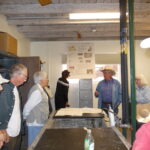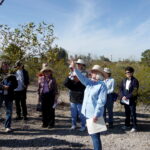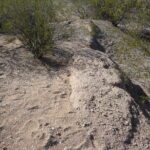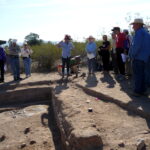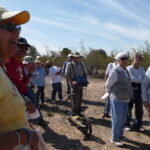
On August 21, 1865 a garrison of California Volunteer Infantry and Cavalry established the site of Fort Mason under command of Colonel Charles W. Lewis. The fort was established below the Spanish Colonial Mission site of Calabazas close to the present day International Wastewater Treatment Plant in Rio Rico, on the Upper Santa Cruz River 8 miles from the Mexican border. Fort Mason was established to conduct operations against Apaches, monitor the French secessionists, protect mail and transportation routes, and patrol the border area against Mexican imperialists and the Confederate Army. The old mission church ruins of Calabazas, which are now part of Tumacacori National Historical Park, were reused as the officers quarters for Fort Mason. Although the history of Fort Mason is mentioned in a few local histories and by scholars of California military history the full story of this short lived military outpost remains untold.
Fort Mason was never finished and the fort was moved to Fort Buchanan at the headwaters of Sonoita Creek in 1866. The cavalry at Fort Mason included the California Native Cavalry lancers, the last of their kind who came to AZ looking to serve their country and to prospect for land and new beginnings. The Fort consisted of a tent camp, barracks buildings, hospital, some adobe quarters, corrals that were never finished. Almost forty soldiers died from “malarious fever,” most of who are now buried at the San Francisco National Cemetery.
The archaeological site of Fort Mason and the earlier Camp Moore (1856-57) are located on private property owned by Rio Rico Properties. The site was excavated by faculty and students of Defiance College, Ohio, from the early 1970s through mid-1980s. The collections were never analyzed and there is not final report on the results of the investigations. Rio Rico Properties has deeded the artifacts and archives to the Arizona State Museum. With help from the Arizona State Museum AAHS arranged for the transport of these materials back to the Arizona State Museum. Volunteers, under the leadership of Homer Thiel, are currently currently preparing the 88 boxes of materials for analysis and curation. The goal to is to finally tell the full story of Fort Mason, and of those who were there during a particularly turbulent time in southern Arizona’s history.
This acquisition is significant, both because of its obvious historical relevance to southern Arizona and its research value as a “snapshot in time” of military life in the Arizona Territory. We anticipate that the outcome in addition to proper curation of the collection, will be a final report and publication on the Defiance College excavations, and a temporary exhibit at the Arizona State Museum.
Please donate and help support the acquisition and study of this important collection! Help bring this snapshot of Arizona history to life by donating to this exciting project.
Donate to the Fort Mason Campaign
The planned lectures are:
Tuesday 15 Oct
- Overview of the Hohokam Sequence. (Patrick Lyons)
- The Early Agricultural Period and the pre-Classic, with special focus on
- Hohokam Subsistence and Tumamoc Hill. (Paul Fish)
Tuesday 22 Oct
- The Hohokam Classic Period with a focus on Marana and University Indian Ruins. (Suzanne Fish)
Tuesday 29 Oct
- The Protohistoric Period with comparative data from the San Pedro and other nearby areas. (Patrick Lyons)
Tuesday 5 Nov
- The Tucson Basin and Beyond: Hohokam Population Trends through Time: a synthesis of settlement patterns. (Matthew Peeples)
- Panel Discussion and Question/Answer Session.
Suggested Reading:
Fish, Suzanne K. and Paul R. Fish (editors)
The Hohokam Millennium. School for Advanced Research Press, Santa Fe (2007).
The AAHS Scholarships and Research Grants Committee has awarded four $1,000 research grants to applicants from four Universities as well as six $300 travel grants for students to attend the SAA meeting. Research grants were awarded to Michael Mathiowetz, Adjunct Faculty at California State University, Dominquez Hills for documenting and analyszing a large collection of Aztatlan ceramics in Nayarit, Mexico; Kristen Safi a graduate student at Washington State University for test excavations at the Large Gap Chaco-style great house community in New Mexico; Jakob Sedig, a graduate student at the University of Colorado for test excavations at Woodrow Ruin, a Mimbres Classic site in the Upper Gila region of New Mexico and to Andrew Richard, an undergraduate student at the University of Arizona for an experimental study on breakage patterns of Clovis and Folsom projectile points. Congratulations to all!
Erina Gruner, doctoral student from SUNY Binghamton is the winner of 2012 The Julian D. Hayden Student Paper Competion sponsored annually by AAHS and AAC. Erina’s paper is entitled “Re-envisioning Nativism: The Use of Ecclesiastical Paraphernalia during the Pueblo Revolt”.
NOTE SPEAKER CHANGE!
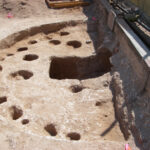
In 2006, Pima County initiated one of the largest and most complex archaeological projects ever undertaken in Arizona, involving the complete excavation of nearly an entire civilian and military cemetery. Because the entire parcel was planned to be developed in to a Joint City-County Courts Complex, state law required the complete recoverey and removal of burials from the site and their repatriation to descendant groups. The excavation resulted in the recovery of nearly 1,400 individuals buried during Tucson’s Territorial Period from the 1850’s to 1880’s, together with more than 700 archaeological features dating to the post-cemetery and prehistoric periods.
AAHS has issued a call for proposal for the annual awards for Research Scholarships and Travel Grants. Proposals are due between January 1 and February 15, 2012. For more information click here.

The new AAHS T-shirts designed by Janine Hernbrode and featuring Hohokam burden carriers over a petroglyph design from Cerro Prieto are now available in our on-line store.

The Arizona Archaeological and Historical Society was founded on April 14, 1916 by Byron Cummings and some of his associates including: Nelson Bledsoe, a medical doctor from Bisbee; Ida Douglass, the wife of A.E. Douglass of tree-ring dating fame; Robert Forbes, Professor of geography, physiology and chemistry at the University of Arizona and the planter of the olive trees outside the Arizona State Museum; Hattie Ferrin Solomon one of the four graduates of the University’s Class of 1898 and a founder of the Tucson Symphony Orchestra as well as the proprietor of a dress shop located in what is now Franklin’s outside of the University main gates; G.E.P. Smith of the University faculty who wrote the first Arizona Water Code and drafted Tucson’s first zoning ordinances as well as Senator Carl Hayden. Byron Cummings was the legendary Dean of the Department of Archaeology (now Anthropology) at the University of Arizona as well as the Director of the Arizona State Museum.
Drs Paul and Suzanne Fish will lead a tour of University Indian Ruins, the site of the current University of Arizona Field School. This 13-acre property located in Indian Ridge Estates was a gift to the School of Anthropology in the 1930s and includes one of the last remaining Hohokam Classic Period platform mound sites in the Tucson Basin (ca. A.D. 1325-1450). To sign up contact Katherine Cerino.


The Arizona Archaeological and Historical society is pleased to announce the receipents of the 2010 awards. J. Jefferson Reid and David E. Doyel will receive the 2010 Bryon S. Cummings Award for outstanding contributions in Archaeology, Anthropology, or Ethnology. The Victor R Stoner Award for Outstanding Contributions to Public Archaeology or Historic Preservation will be presented to James M. Copeland and William H. Doelle. The awards will be made at the annual Pecos Meeting in August.
- Fort Bowie from Overlook Ridge
- Helen’s Dome
- Little Robe’s Marker
- Group at Old Butterfield Stage Stop
